
Lugo is a city in northwestern Spain in the autonomous community of Galicia. It is the capital of the province of Lugo. The municipality had a population of 100,060 in 2024, making it the fourth most populous city in Galicia.

Callosa d'en Sarrià (Valencian:[kaˈʎozaðensariˈa] is a Valencian town and municipality located in the comarca of Marina Baixa, in the province of Alicante, Spain, lying in the valley of the river Guadalest, 50 km from the city of Alicante. Callosa d'en Sarrià has an area of 24.8 km2 and according to the 2003 census, a total population of 8,060 inhabitants. The economy of Callosa is chiefly based on tourism and agriculture: it is the main producer of loquat in Spain. The most important monuments in the town are the Catholic archipresbyteral church of Sant Joan Baptista, built in the 18th century, and the Fortress of Bèrnia, built in the 17th century at the top of a nearby mountain to defend the city from pirates and Moriscos.
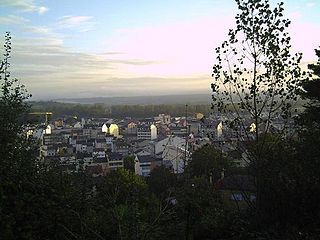
Sarria is a municipality in the province of Lugo, in the autonomous community of Galicia, northwestern Spain. It belongs to the comarca of Sarria. Sarria is the most populous town on the French Way in Galicia, with 13,700 inhabitants and the major is Carmen José Lòpez. It is head of the region and the most popular starting point for the Camino de Santiago; many pilgrims choose Sarria because the distance from this point to Santiago allows them to cover the necessary kilometers to reach the Compostela. King Alfonso IX of León died in Sarria in 1230 while making a pilgrimage to Santiago de Compostela.

Baralla is a municipality in the province of Lugo, in the autonomous community of Galicia, Spain. It belongs to the comarca of Os Ancares and covers 30 villages. Until the late 1970s it was called Neira of Jusá.

Samos is a municipality in the province of Lugo in the autonomous community of Galicia, Spain. It belongs to the comarca of Sarria.
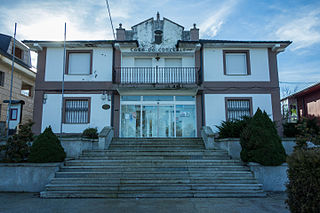
Paradela is a municipality in Lugo province in Galicia in north-west Spain. It is situated in the region of Sarria. There were 2,193 people living in Paradela as of 2008 . It is known for the connection it has with the Way of St. James. The French route of such a way, ending in Santiago de Compostela, passes through five parishes of Paradela: Ferreiros, Francos, Laxe, Cortes and Loio.

Lourenzá is a municipality in the province of Lugo, in the autonomous community of Galicia in northwestern Spain.
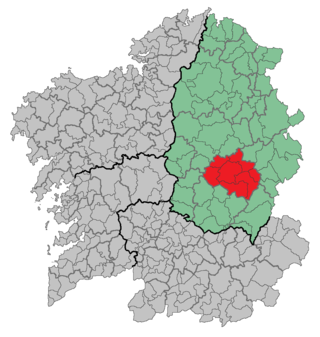
Sarria is a comarca in the Galician Province of Lugo. The overall population of this local region is 22,569 (2019).

Riotorto is a municipality in the province of Lugo, in the autonomous community of Galicia, Spain. It belongs to the comarca of Meira.

O Páramo is a municipality in the province of Lugo, in the autonomous community of Galicia, Spain. It belongs to the comarca of Sarria. It has a population of 1632 persons and an area of 74.92 km2.
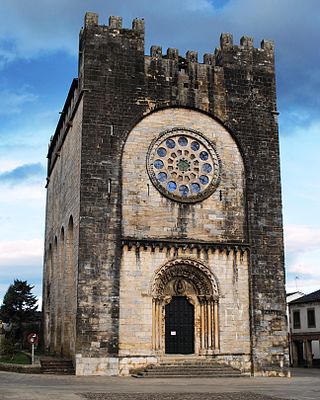
Portomarín is a municipality in the province Lugo, in the autonomous community of Galicia, Spain. It belongs to the comarca of Lugo. The town has a population of 1345 and an area of 115 km². It is one of the towns in the pilgrimage route known as the French Way, part of the Camino de Santiago.

A Pobra do Brollón is a municipality in the province of Lugo in the autonomous community of Galicia, Spain. It belongs to the comarca of Terra de Lemos. It has a population of 2,066 and an area of 175 km2.

Fernando Villapol Parapar is a museum curator and art critic, most famous as a contemporary Galician sculptor. He currently lives and works in the town of Bretoña (Lugo) located in Galicia. He is also the founder of the Ethnographic-Pedagogic Museum in Bretoña. He studied at the College of Applied Arts in Lugo, Spain, although can be considered an autodidact, attributing most of his knowledge and acquired skills through his self-funded travels and investigations of sculpture across the globe.

Fruxil is a small rural village in the parish of A Cervela in the municipality of O Incio, Spain. Belonging to the Shire of Sarria, in 2010 it consisted of 18 houses and according to INE its stable population was estimated at 36 neighbors.
Sarria is a municipality in the province of Lugo, Galicia, Spain.
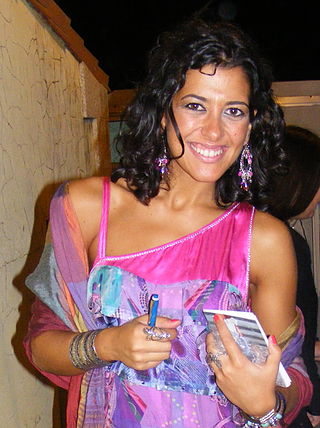
Lucía Pérez Vizcaíno is a Spanish singer who represented her country in the Eurovision Song Contest 2011 in Germany with the song "Que me quiten lo bailao".

Luis Ángel Sánchez Pereiro alias Lois Pereiro was a Galician poet and writer.
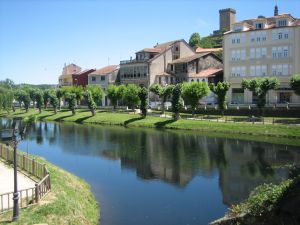
The Cabe is a river in the province of Lugo, Galicia (Spain), Spain, tributary of the Sil River. The river is 56 km long and flows through the municipalities of Inicio, Puebla del Brollón, Monforte de Lemos, Pantón and Sober, Lugo. It occupies an areas of 1577 hectares and has contamination problems in some spots in its southern end.

José Manuel Barreiro Fernández is a Spanish politician and senator. Barreiro is a member of the People's Party of Spain. He was elected senator to represent the Lugo district. He has been senator in the Cortes Generales of Spain since 1 April 2008.
In the run up to the 2023 Spanish local elections, various organisations carry out opinion polling to gauge voting intention in local entities in Spain. Results of such polls for municipalities in Galicia are displayed in this article. The date range for these opinion polls is from the previous local elections, held on 26 May 2019, to the day the next elections will be held, on 28 May 2023.





















